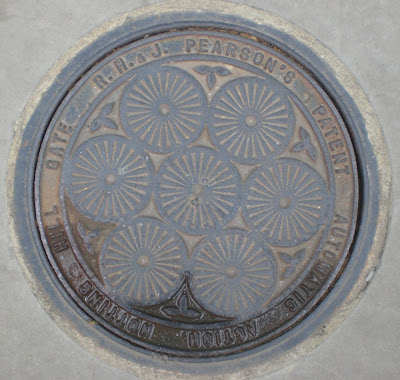I had to make a quick trip up to town the other day and I managed to remember to take the camera with me. Not that I was out for long, just a short trip from Sloane Square tube along the Kings Road to Flood Street, but I did take the opportunity to have a quick stroll down a few side streets to see if I could spot any interesting odds and ends.
As it turns out, the side streets off the Kings Road in Chelsea have some very nice terraced houses and as few of them seem to have avoided having their pavements replaced (for the time being at least) I had a bit of a bonanza with the coalholes. One of the effects of having new pavement arriving on a fairly frequent basis seems to be that the coalhole covers themselves are removed - for scrap presumably - the holes are filled then covered and another bit of old London bites the dust. Apart from the ubiquitous Hayward Brothers there did seem to be a very local flavour to the coalhole companies represented. Take this one for example
 |
| Green & London, Chelsea, London, SW |
The London Street Directory of 1921 records the business of Green & London as being situated at 121 Kings Road but apart from having an advert in the 1908 Chelsea Historical Pageant - where they also advertise their Gas & Electrical Fittings; Builders & Engineers supplies and their Brass Foundry - I can't find much more about them.
 |
| C. L. Hacking, 259 Kings Road, Chelsea SW |
 |
| Brass lamps. A welcome change from cast-iron coalhole covers. |
 |
| A. C. Woodrow & Co., London |
1954 might seem a little late in the day for coalhole plates, but A. C. Woodrow & Co were still offering them for sale through publications such as Roads and Road Construction. In fact A.C. Woodrow specialised in cast iron castings throughout their history and are one of the most commonly seen names on manhole covers and other street ironware. They seem to have started off in Holborn, London but then moved out to Kent where they were still going strong at least into the 70s, and even now, for all I know. One interesting snippet caught my eye from the Municipal and Public Services Journal of1970
This golf trophy - imaginatively combining the scale model of a manhole cover surmounting three silver replicas of the Minoan axe - has been presented to the staff of Milton Keynes Development Corporation by A. C. Woodrow and Company. The Woodrow trophy will be presented annually...[at] the Tower Club...
Sadly I couldn't find a picture of this 'imaginative' trophy. I wonder if it's still being contested to this day?
 |
| J. W. Carpenter, 186-190 Earls Court Road, SW |
Quite an interesting design here produced by J. W. Carpenter Ltd., which reminds me somewhat of a compass design. According to Gillian Cooksey in her book "Artistry & History Underfoot" has looked into the history of the company and apparently it's still trading as the Cargo Homeshop, currently celebrating its 135th birthday!
 |
| R. R. & J. Pearson, Patent Automatic, Notting Hill Gate |
The Pearson's not only seem to be significant local ironmongers, as evidenced by the number of coal-hole plates in the area, but were also engaged in speculative building projects. Sadly this doesn't always seem to have gone quite to plan every time. In 1869 R. H. Pearson (ironmonger of Notting Hill) and a Mr Tidesley (brickmerchant) appear as trustees seeking the bankruptcy of Henry Saunders (builder) of Kensington. A later appearance in the records shows that by 1893 The Statist magazine was discussing the make up of Mr Robert Henry Pearson's wealth (and the fact that he had over 200 people working for him at the time) so presumably that was the year of his death. The business carried on though and in 1900 the British Architect magazine were reporting news of other, more domestic products, although coal hole plates were still on the menu
RH & J. Pearson, Limited, wholesale and manufacturing ironmongers, High Street, Notting Hill, W., have just issued an illustrated catalogue of their well- known specialities in close and open-fire kitchen ranges
So a significant supplier of local coal hole plates then and appearing on our posting today with what I think is a very attractive design with the seven circles with leaf cluster details.
 |
| Durey |
This Durey plate is a bit of a puzzle. There were plenty about and compared to the others its fairly plain typeface and layout seems to be more modern in style. My first thought was that the plate might have been the work of a modern company of the same name, Durey , who specialise in manholes. However, according to their website they were only formed in 1975 which I would have thought was a little on the late side fro coalhole plates. So, it seems there's a bit of a mystery to end on with this one...









